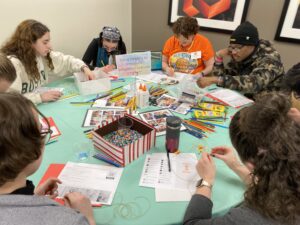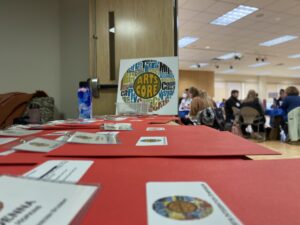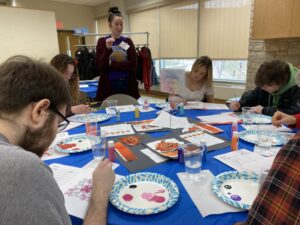Contact ArtsCore
(920) 424-4628
Arts and Communications
2024 Arts Integration Symposium
March 20, 2024, 12:30-4:00pm
Registration for this event has closed.
This event is designed for pre-service and practicing teachers to learn about arts-integration through hands-on round table sessions led by local teachers using this practice. Participants will leave the event with multiple ready-to-use arts integration lesson plans that students will love!
All pre-service and practicing teachers are welcome to attend regardless of their licensure areas.
2024 Roundtable Offerings
2D and 3D Arts Integration
Bonnie Smith (OASD, WIT Academy) & Ashley Molder (OASD, Roosevelt Elementary)
Learn how to make both 2D and 3D models of an igloo for the study of early American peoples, specifically the Inuit People and their earlier dwellings.
Art: Foiled Again!
Katie Stadler (OASD, Vel Phillips Middle School)
An overview of how to make scratch art from scratch, and how you can use it in almost any lesson, even if you think you might not be able to.
Blackout Galaxy Poems
Casey Abrahamson (OASD, Vel Phillips Middle School)
Students use a passage or page ripped from an old book and extract words to compose a poem. They then obscure the words they chose to omit from the poem, and they have the option to embellish it with art or simply black it out.
Channel Your Inner T-Swift: Building a Class Family with Friendship Bracelets
Madeline Knoblock (OASD, Emmeline Cook Elementary School)
Learn how to create a sense of classroom community/family with the book The Circles All Around Us and embroidery floss friendship bracelets.
Desire to Go Back in Time and Build a Tipi
Huma Malik (OASD, North High School)
Learn about the variety of home construction methods utilized by Native Americans and construct one of your own utilizing resources based on region.
Get Dancing to Science
Brittany Sperberg (AASD, Jefferson Elementary, Fox River Academy)
Build connections to science units, terms, and concepts through the application of Laban’s Effort Elements of Motion. In one example, students compose dance/movements to enhance understanding of soundwaves.
Harmony of Emotions: Exploring Color and Emotional Literacy
Katie Parker (AASD, Kaleidoscope Academy) & Laura Dickenson (AASD, Kaleidoscope Academy)
Students will learn about the representation of emotion through color, and they will track their daily mood using symbols and watercolor. After a month of tracking, students will be able to see what artistic masterpiece their emotions create.
Harvesting the Seasons: Painting the Seasonal Round of Wisconsin Indigenous Peoples
Stephen Hilger (OASD, ALPs Charter School)
Students make a mural of the seasonal round that Wisconsin Indigenous people traditionally engage in each year as they harvest plants and animals with the seasons in Wisconsin.
Incorporate Sketching in the Secondary Classroom
Bobbi Cummings (OASD, North High School)
Learn about sketchnoting and other ways to incorporate drawing in the classroom to increase student engagement and learning.
Mindful Mandalas
Shandee Kempf-Cohen (AASD, Kaleidoscope Academy)
This session will focus on mindfulness through introducing the concept of mandalas and their symbolic representation of unity and harmony. We will discuss how mindfulness through mandalas can build connections in the classroom.
Moon Phases
Madysen Weiss (OASD, Carl Traeger Elementary School)
Students learn about the night sky through Mystery Science Curriculum. They will create and paint a clay moon that represents a phase of the moon cycle.
Partial Product Production: Perler Beads for Area Model of a Rectangle
Nikki Rapp (OASD, Vel Phillips Middle School)
Use partial products to build rectangles with perler beads to show how to break apart numbers when multiplying. Add key chains to display models on backpacks.
Put Me In, Coach! Instructional Coaching in Arts Integration
Sarah Phelps (AASD, Badger Elementary School) & Molly Pokwinski (AASD, Badger Elementary School)
Learn how an instructional coach, homeroom teachers, and a music teacher collaborated to craft an arts-integrated unit that addressed standards in ELA, Inquiry, Art, and Music. Students and staff loved the unit so much they are extending this style of planning and teaching beyond the coaching cycle! Roundtable participants will connect a text/music to their lived experience and create a personal symbol.
Sketchnoting as a Building Block to a Summative Picture Book
Camryn Annoye (AASD, Kaleidoscope Academy)
Learn how to use Sketchnoting to model the complexities of a children’s book. There will be an example of how to use Sketchnoting to develop an understanding of the content in a children’s book, while also identifying the illustrator’s art style and writing technique.
Snap Word Creations
Becca Beschta (OASD, Read Elementary School) & Cindy Keberlein (OASD, Read Elementary School)
Students review snap, high frequency, or vocabulary words to create a poster (or crossword puzzle) using Elkonin boxes to show those words as well as to remember how they sound when we say them slowly.
Sound Waves and Foley Artistry: The Art of Sound Effects in Media
Daniel Quiroga (AASD, Kaleidoscope Academy) & Kelly Quiroga (AASD, Kaleidoscope Academy)
Sound waves can be difficult for students to imagine as they cannot often be seen and only felt in extremes. Foley Artistry allows students to explore how pitch, timbre, and frequency are used in many types of media arts to produce practical sounds.
Trading Cards
Stafani Karl (AASD, Badger Elementary School) & Haley Schwanebeck (AASD, Badger Elementary School)
Create trading cards to demonstrate learning about animal traits/habitats (2nd grade) or Native American cultures in the northeast region (4th grade).
Transcendentalism: Books, Beliefs, and the Beyond
Darien Olson (AASD, Fox Cities Leadership Academy, North High School)
“Everything is connected,” is Commoner’s first law of ecology and a core tenet of the nineteenth century philosophy of Transcendentalism. In this brief exploration, participants will explore a central Transcendental text before immersing themselves in scientific sketching and mindfulness practices.
We Remember: Butterfly Project
Leah Rubsam (AASD, Kaleidoscope Academy)
Students write adapted narratives about a victim/survivor of the Holocaust. Students use art elements to create a butterfly that represents their victim/survivor and write a script to share their butterfly with peers from other classes.



